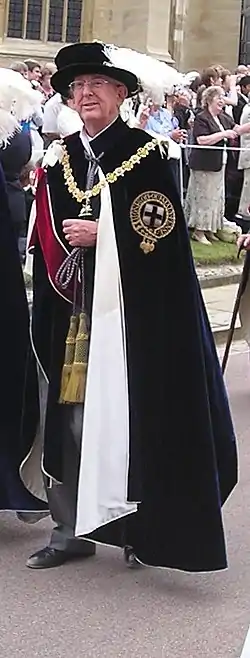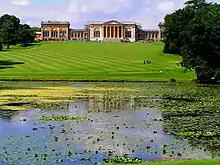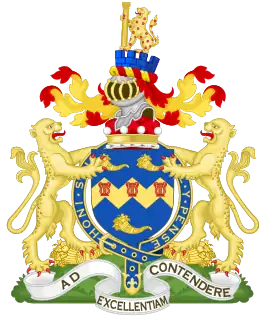John Sainsbury, Baron Sainsbury of Preston Candover
John Davan Sainsbury, Baron Sainsbury of Preston Candover, KG (born 2 November 1927) is the President of Sainsbury's, a British businessman, and a politician. He sits in the House of Lords as a member of the Conservative Party.
The Lord Sainsbury of Preston Candover | |
|---|---|
 Lord Sainsbury in the robes of a Knight of the Garter | |
| Born | John Davan Sainsbury 2 November 1927 |
| Alma mater | Worcester College, Oxford |
| Known for | businessman, politician and peer |
| Net worth | £1.3 billion[1] |
| Political party | Conservative Party |
| Parent(s) | Alan Sainsbury |
| Relatives | Robert Sainsbury (uncle) |
Early and private life

He is the son of Alan Sainsbury, Baron Sainsbury, and the nephew of Sir Robert Sainsbury. His younger brothers are Simon and Timothy, former Conservative Minister of Trade; David Sainsbury, former Labour Minister for Science, is a cousin. His great-grandparents, John James Sainsbury and Mary Ann Staples, established a grocer's at 173 Drury Lane in 1869 which became the British supermarket chain Sainsbury's. He is sometimes referred to as "Mr JD" Sainsbury (which is what he was known as when working for Sainsbury's).
Lord Sainsbury was Head Boy of Sandroyd School before heading to Stowe School and Worcester College, Oxford, reading History.
He is married to the former ballerina Anya Linden. They have three children: Sarah Butler-Sloss (born 1964), John Julian (born 1966) and Mark (born 1969).
When he bought his 18th-century mansion at Preston Candover in Hampshire, from the previous owner Peter Cadbury, he replanted trees that Peter Cadbury had cut down to make the house look bigger.
He was knighted in 1980 for services to the food retailing industry,[2][3] and was made a life peer on 31 January 1989 with the title Baron Sainsbury of Preston Candover, of Preston Candover in the County of Hampshire.[4][5] He became a Knight of the Garter in 1992.[6]
Business career
Lord Sainsbury joined Sainsbury's in 1950 (the year the first self-service store opened in Croydon), working in the grocery department. The next year he became a buyer.[7] He later became in charge of many other aspects of the business, including bacon buying in 1956. He became a director of the Company, then known as J. Sainsbury Ltd., in 1958, becoming Deputy chairman in 1967 following his father Alan Sainsbury's retirement.
Lord Sainsbury took over from his uncle Sir Robert Sainsbury as chairman and chief executive in 1969. At the time, although Sainsbury's had always been the largest UK grocery retailer by market share since 1922, Tesco's profits were double those of Sainsbury's, and Marks & Spencer's were nine times those of Sainsbury's.
He led the company on to the London Stock Exchange on 12 July 1973, which was at the time the largest flotation ever. Dubbed "The sale of the century" by the press, his family at the time retained control with an 85% stake. Whilst his cousin, David Sainsbury, inherited his father Robert Sainsbury's entire 18% shareholding, Lord Sainsbury had to split his father Alan Sainsbury's 18% stake with his younger brothers The Hon. Simon Sainsbury and The Rt Hon. Sir Timothy Sainsbury, and so they held 6% each. It is believed that Robert Sainsbury gave David Sainsbury his entire shareholding (rather than split it between David and his three daughters) so that David would have more votes at the table, considering JD had a forceful, autocratic style of leadership, whereas David was always more cautious (and always seemed less interested in the family business than JD (David having only joined Sainsbury's personnel department as he did not get the grades to become a scientist)).
During his 23 years as chairman, Sainsbury's replaced all its 82 counter service stores with modern supermarkets, and the number of UK grocery stores increased from 244 stores (including 162 self-service shops) to 313 supermarkets, whilst the average size of new supermarkets increased from 8,120 sq ft (754 m2) to 34,980 sq ft (3,250 m2). The range of products increased from 4,000 (including 1,500 own brand products) to 16,000 (including 8,000 own brand products). He was said to personally taste own brand products himself to make sure he was satisfied with its quality control, and personally approved every own brand product packaging design himself before the official launch of each new own brand product. He was said to turn up unannounced at stores by helicopter to patrol the aisles and highlight deficiencies.[8]
He led Sainsbury's into the USA through the purchase of Shaw's, a USA supermarket chain, and started both the Homebase and Savacentre ventures. Shaw's and Homebase have since been sold, whilst Savacentre has been re-branded under the core Sainsbury's brand.
Between 1973 and 1992, the company's market capitalisation increased from £117m to £8.115bn due to an increase in the share price from 9p to 464p (on 15 May 1992). Between 1969 and 1992 sales increased from £166m to £9.202bn and profit before tax increased from £4.3m to £628m. The Company also boasted the highest sales per square foot in the food retailing industry and the market share of the UK supermarket business increased from 2.5% to 10.4%. Sainsbury's also overtook both Tesco and Marks & Spencer (the latter shortly before his retirement on his 65th birthday on 2 November 1992) to become the UK's largest and most successful supermarket chain. Following his retirement, his cousin and Labour supporter David Sainsbury (now Lord Sainsbury of Turville) became chairman. Tesco overtook Sainsbury's to become the UK's largest supermarket chain in 1995, and David Sainsbury stepped down as chairman in 1998 to pursue his long-held ambition to have a career in politics.
Although Lord Sainsbury has retired, he is Life President of the retailer and continues to take an active interest in the business; these days he tours stores with present chief executive Mike Coupe as well as being the family member always attending J Sainsbury plc Annual General Meetings. He also serves as a Joint President of the Sainsbury's Veteran Association along with former Sainsbury's CEO Dino Adriano.
He is also the family member with a large shareholding that is most reluctant to sell down his stake. During the sell down of the family stake between 2005 and 2008 from 35% to 15%, it was Lord Sainsbury who was the last major family shareholder to reduce his stake, in his case from 4% to 3.89%, the 0.11% sold having belonged to a non-beneficial trust held by him.
J Sainsbury plc was informed on 5 December 2006 by Lord Sainsbury of Preston Candover, that he no longer holds a reportable interest in the Company following the transfer of shares within his family. As a result, his 3.89% shareholding in Sainsbury's is no longer reportable.
During the takeover bids for Sainsbury's during 2007, Lord Sainsbury used N M Rothschild & Sons as his financial advisor and was said to be the major family shareholder most resistant to selling his stake. Indeed, during the private equity takeover bid during the first half of 2007, he was said to be refusing to sell his stake of just under 3% at any price.
As of August 2009, Lord Sainsbury continues to control just under 3% of the company, and benefits from 1.6% of the equity included in the above. Although David Sainsbury controls the largest family shareholding of 5.85%, and Lord Sainsbury controls just under 3%, the beneficial holding of David Sainsbury is only 0.57%, compared with 1.6% for JD Sainsbury. The Sainsbury family as a whole control approximately 15% of Sainsbury's. In the Sunday Times Rich List 2013 his family fortune was estimated at £1.97 billion.[9]
He is a former member of the Steering Committee of the Bilderberg Group.[10]
Charitable works
In 1985 he and his two brothers provided funds to construct a new wing of the National Gallery, London at a cost of around £50 million, which opened in 1991 as the Sainsbury Wing.[11]
With his wife, he also runs the Linbury Trust, which offers grants to various projects in the fields of the Arts, Education, Environment & Heritage, Medical, Social Welfare and Developing Countries. One of the most notable projects funded by the Linbury Trust was the 1990s redevelopment of the world-renowned Royal Opera House in London. The Linbury Studio Theatre in the building is named in recognition of the substantial contribution made by the trust.
Most notably contributing a considerable amount towards the redevelopment of the Royal Opera House. The Linbury Studio Theatre is named in recognition of the major contribution to the redevelopment of the Royal Opera House. In 1987, Lady Sainsbury founded the bienniel Linbury Prize for Stage Design, which identifies and encourages talented newcomers to the field of theatre design; the Prize continues to be funded solely by the Linbury Trust.
In 1993, he joined with Lord Rothschild to set up the Butrint Foundation to record and conserve the archaeological site of Butrint in Albania.
In September 2010 he donated £25m to the British Museum, which the BBC reported as the biggest gift to the arts in two decades.
Arms
 |
|
References
- "Lord Sainsbury and family". Sunday Times Rich List 2008. 27 April 2008. Retrieved 20 April 2009.
- "No. 48059". The London Gazette (Supplement). 8 January 1980. p. 288.
- "No. 48160". The London Gazette. 18 April 1980. p. 5815.
- "No. 51640". The London Gazette. 8 February 1989. p. 1615.
- http://www.parliament.uk/biographies/lords/lord-sainsbury-of-preston-candover/2162
- "No. 52903". The London Gazette. 24 April 1992. p. 7175.
- "Lord Sainsbury of Preston Candover". The Grocer. Retrieved 3 November 2014.
- "Is running Sainsbury's the worst job in Britain?". The Guardian. London. 18 April 2004.
- "Sunday Times Rich List: The changing face of wealth". BBC News. 18 April 2013.
- "Former Steering Committee Members". bilderbergmeetings.org. Bilderberg Group. Archived from the original on 2 February 2014. Retrieved 8 February 2014.
- "The Sainsbury Brothers". The National Gallery.
- Image of the Baron Sainsbury's arms at St George's Chapel Archived 31 December 2013 at the Wayback Machine. Retrieved 24 December 2013
- Baron Sainsbury's crest.Heraldic Sculptor. Retrieved 24 December 2013
- Sainsbury of Preston Candover's Arms Blazon, Cracroft's Peerage. Retrieved 14 January 2014
External links
- John Davan Sainsbury on John-Sainsbury.com Retrieved 21 March 2010
| Orders of precedence in the United Kingdom | ||
|---|---|---|
| Preceded by The Lord Plumb |
Gentlemen Baron Sainsbury of Preston Candover |
Followed by The Lord Clinton-Davis |

